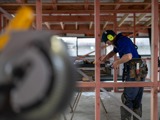When a building is brought to the Council’s attention as being possibly dangerous, affected and/ or insanitary, Council will undertake investigation to determine whether that building is dangerous, affected and/ or insanitary as defined in the Building Act 2004, before taking the actions required under Council's policy and the Act.
If investigation is done in response to a District Court Order under section 126 of the Act or through a warrant issued by Council’s Chief Executive under their signature to remove any immediate danger under section 129 of the Act, then the building owner will be liable for Council costs.
When a building is determined as being dangerous, affected, and/ or insanitary, Council will perform its responsibilities under section 124 of the Act.
This may include but is not limited to:
- Putting up a hoarding or a fence to prevent people from approaching the building,
- Attaching a notice that warns people not to approach the building,
- issuing a written notice notifying the work required to be carried out on the building to reduce or remove the danger or to prevent the building from remaining insanitary,
- Placing a notice on the determined building that prevents people from using it, and
- Restricting entry to the building for particular purposes or particular persons or groups of persons.
All possible dangerous insanitary or affected buildings will be assessed in accordance with Councils Dangerous Insanitary Affected Risk Matrix with priority given to medium to higher risk type buildings.
Any building(s) determined as being dangerous, affected, and/ or insanitary will have a notification and a list of necessary remedial actions placed in the corresponding property file maintained by Council until the issues are resolved.
Moreover, while a building is classified as dangerous, affected, or insanitary, specific details will be included on any Land Information Memorandum (LIM) or Project Information Memorandum (PIM) if it impacts proposed building activities.
This information will consist of a declaration of the building's status, a copy of the notification detailing required remedial work and compliance deadlines, and a copy of any letters sent to owners, occupants, and affected parties regarding the building's condition, including evacuation notices if issued.
Data pertaining to such buildings will be accessible through the relevant LIM or PIM, with Council adhering to the disclosure guidelines outlined in the Local Government Official Information Act 1987 and the Local Government Act 2002.
If Council is satisfied that a building is dangerous, affected or insanitary, and determines that it is appropriate to take action, it may serve notice on the owner. There are specific requirements for the form of these notices and how they must be issued.
Where a notice confirms that remedial work is required, the council may inspect the property or take some other step to confirm the work has been carried out within the timeframes stated on the notice.
It is an offence to fail to comply with a notice, issued Council, requiring work to be carried out on a building to reduce or remove danger, or prevent the building from remaining insanitary.
If the building has heritage status, Heritage New Zealand Pouhere Taonga will be consulted, and the process will not increase the physical danger to the public.




